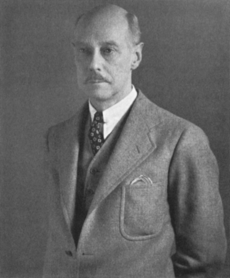
Raymond Ditmars
Encyclopedia

United States
The United States of America is a federal constitutional republic comprising fifty states and a federal district...
herpetologist
Herpetology
Herpetology is the branch of zoology concerned with the study of amphibians and reptiles...
.
Ditmars was very interested in animals, (primarily reptile
Reptile
Reptiles are members of a class of air-breathing, ectothermic vertebrates which are characterized by laying shelled eggs , and having skin covered in scales and/or scutes. They are tetrapods, either having four limbs or being descended from four-limbed ancestors...
s), obtaining his first snake
Snake
Snakes are elongate, legless, carnivorous reptiles of the suborder Serpentes that can be distinguished from legless lizards by their lack of eyelids and external ears. Like all squamates, snakes are ectothermic, amniote vertebrates covered in overlapping scales...
s at twelve years of age. Only a mediocre student, he much preferred vacations when he could search for new specimens or study them at his house.
In 1893, Ditmars was hired by the Department of Entomology
Entomology
Entomology is the scientific study of insects, a branch of arthropodology...
at the American Museum of Natural History
American Museum of Natural History
The American Museum of Natural History , located on the Upper West Side of Manhattan in New York City, United States, is one of the largest and most celebrated museums in the world...
as an illustrator. He quit in 1897 to take a better-paying job as a stenographer. In July 1898, he began to report for the New York Times. One of his first pieces led him to discover the newly created New York Zoological Society, which had just built a zoological park in the Bronx. He was soon employed as an assistant conservationist in charge of reptiles in July 1899. He then offered his own collection to the zoo, where it is now a permanent part of the natural history
Natural history
Natural history is the scientific research of plants or animals, leaning more towards observational rather than experimental methods of study, and encompasses more research published in magazines than in academic journals. Grouped among the natural sciences, natural history is the systematic study...
museum. This began a long collaboration between Ditmars and the Bronx Zoo
Bronx Zoo
The Bronx Zoo is located in the Bronx borough of New York City, within Bronx Park. It is the largest metropolitan zoo in the United States, comprising of park lands and naturalistic habitats, through which the Bronx River flows....
. In 1926 he was placed in charge of the mammal
Mammal
Mammals are members of a class of air-breathing vertebrate animals characterised by the possession of endothermy, hair, three middle ear bones, and mammary glands functional in mothers with young...
s, and in 1940 the insect
Insect
Insects are a class of living creatures within the arthropods that have a chitinous exoskeleton, a three-part body , three pairs of jointed legs, compound eyes, and two antennae...
s. His presence helped the Bronx Zoo achieve a world-class status.
Ditmars published several books on zoology
Zoology
Zoology |zoölogy]]), is the branch of biology that relates to the animal kingdom, including the structure, embryology, evolution, classification, habits, and distribution of all animals, both living and extinct...
, his own life, and his travels. The Reptile Book was released in 1907 to great success; it was republished and expanded several times. With Reptiles of the World in 1910 (edited and expanded in 1933), Snakes of the World in 1931, Reptiles of North America in 1936 and Field Book of North American Snakes in 1939, he helped tap a large public interest in reptiles. Many herpetologists have said that they first fell in love with reptiles in part through reading Ditmars' books.
His other books were also a success: Strange Animals I Have Known in 1931, and three autobiographies
Autobiography
An autobiography is a book about the life of a person, written by that person.-Origin of the term:...
, Confessions of a Scientist (1934), The Making of a Scientist (1937) and Thrills of a Naturalist's Quest (1939).
Ditmars also helped bring about the antivenom
Antivenin
Antivenom is a biological product used in the treatment of venomous bites or stings. Antivenom is created by milking venom from the desired snake, spider or insect. The venom is then diluted and injected into a horse, sheep or goat...
centers in both the United States
United States
The United States of America is a federal constitutional republic comprising fifty states and a federal district...
and Brazil
Brazil
Brazil , officially the Federative Republic of Brazil , is the largest country in South America. It is the world's fifth largest country, both by geographical area and by population with over 192 million people...
.
Further reading
- Rogers, Cameron (1928). Profiles: Specialist in Snakes. The New Yorker, July 14, 1928, pp. 24–27.

